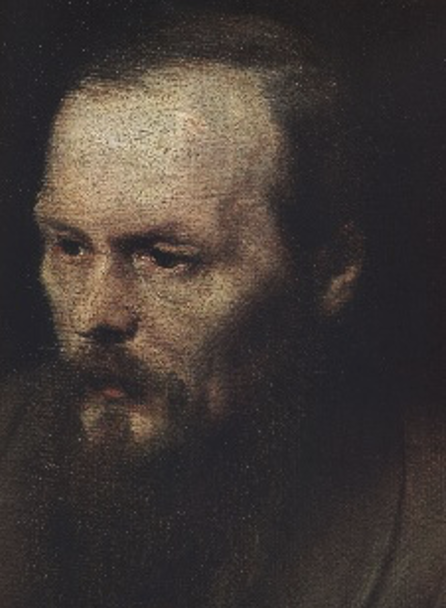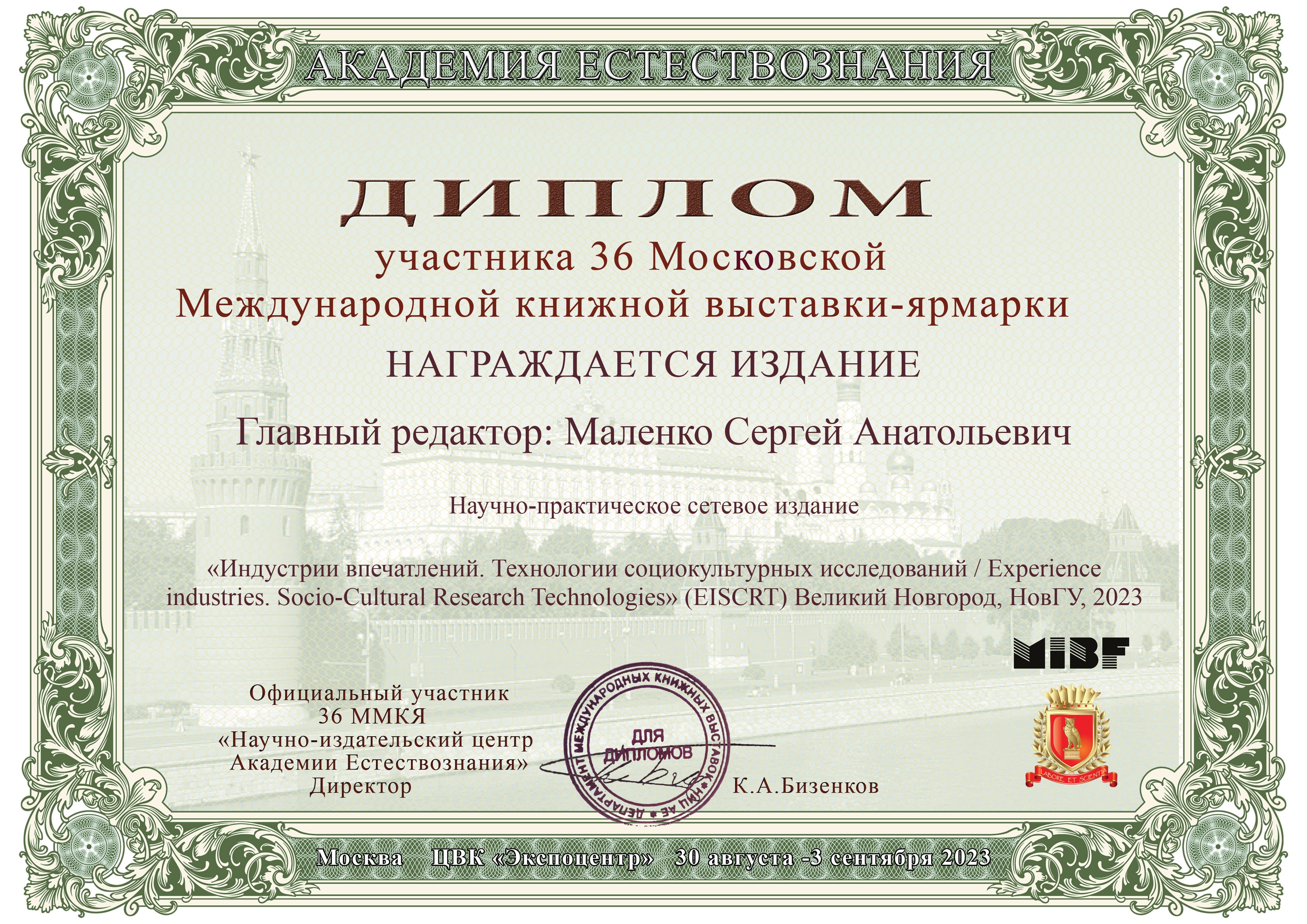Author Guidelines
Download requirements in one file
The indispensable conditions for the publication of an article in "Индустрии впечатлений.Технологии социокультурных исследований / Experience Industries. Socio-Cultural Research Technologies" (EISCRT) are:
- relevance of the chosen topic;
- theoretical and practical significance of the presented research results;
- high scientific level of the publication;
- novelty of the concept, originality of the author's approach;
- structural and compositional completeness of the text of the article;
- strict observance of all technical requirements for the design of the publication.
Materials are accepted in Russian and English.
Articles are sent electronically as .DOCX files to the editorial office email experience@novsu.ru.
File name: author's last name + underscore + number of characters rounded to the nearest hundred, for example, Petrov_310000.docx.
The volume of articles accepted for publication is from 30,000 to 60,000 characters, including spaces (from 0.75 to 1,5 a.l.).
Text Formatting Requirements
Paper size: А4.
Orientation: Portrait.
Margins: left, right – 2,5 cm, the rest – 2 cm.
Font: Times New Roman.
Point size: 14 (main text) and 12 (metadata and bibliography – single spacing).
Alignment: in width.
Paragraph indent: 1,25 pt.
Line spacing: 1,5pt. (for the main text of the article).
Spacing between paragraphs: 0 pt (do not increase the spacing or leave blank lines between paragraphs).
In Russian-language texts, only angular quotation marks («…»), except for two cases:
Quotation of a word written in Latin characters: “Abcdef”, but «Абвгд»;
Quotes inside quotes: «Абвгдабвгд “абвгд” абвгд».
The text of the article should look like this
For publications in Russian:
heading complex in Russian,
main text,
list of references in Russian (header “Литература”),
information about the author in Russian,
heading complex in English without UDC code,
list of references in English (header “References”),
information about the author in English,
information about the funding and status of the study on which the article is based (in a footnote on the first page of the article).
For publications in English, the order of the parts is reversed:
heading complex in English,
main text,
list of references in English (header “References”),
information about the author in English,
heading complex in Russian without UDC code,
information about the author in Russian.
Detailed description of each element of the text
HEADING COMPLEX:
UDC index (UDC – for articles in English).
The classifier can be found at https://www.teacode.com/online/udc/ or https://udcsummary.info/php/index.php
empty line
article title – bold font, 14 point size.
empty line
initials and surname of the author(s) – in italics, 14 point size (right),
- the name of the author in all cases (in the content of the issue, on the slip, in the information about the authors) must be written the same in all languages,
- the text of the article is accompanied by a color portrait photograph in the proportion 4X5 (resolution 300 pt.).
empty line
place of work of the author (city, country).
empty line
the same information is given in English.
empty line
ORCID of the author(s), e-mail of the author(s).
empty line
Abstract in one paragraph. The volume of the abstract is 100–250 words for the abstract in Russian and English:
- the abstract does not allow paragraph division, as well as numbered or bulleted lists and bibliographic references,
- it is undesirable to use abbreviations (except for well-known ones) and formulas,
- single spacing.
Subtitle «Аннотация» or “Abstract” in bold italics.
Subtitle «Ключевые слова» or “Keywords” in bold italics. Key words are given in their initial form:
- quotes are not allowed in keywords (instead of quotes, one can highlight the word in italics),
- keywords should not include complex phrases and phrases, abbreviations, formulas.
- no more than ten words and phrases.
empty line
BODY TEXT
Includes the following sections: introduction, main part, conclusion.
If necessary, the authors have the right to supplement the proposed structure with the following sections:
Problem statement,
Background,
Methodology and research methodology,
Material analysis,
Research results,
Conclusion.
Sections should be titled with the words given.
Within body text, italics are used only to highlight text examples. Key theses or semantic accents can be highlighted in bold. Do not put hyphens (“-”) instead of dashes. An en dash (“–”) is used. If necessary, non-breaking spaces are used (Ctrl+Shift+Space). Lists in the text of the article are drawn up strictly in accordance with punctuation rules. If necessary, only page-by-page (out-of-text) footnotes can be used.
Formatting links and sections «Литература» and “References”
The text uses only inline references formatted according to the following standard: [Surname, year: page number], for example: [Morrison, 2007: 57]. When referring to several papers by the same author in the same year, letters should be used to identify the references [Bromberg, 2008a], [Bromberg, 2008b].
In the list of references, one can only include sources that are referenced in the text!
The list of references should contain at least 15 sources, among which publications indexed in Scopus and WoS, including works by foreign authors, are welcome. No more than two references to own works are allowed.
The list «Литература» and "References" is sorted alphabetically by the names of the authors. For sources without an author, the title is used.
Sections «Литература» and “References” are drawn up in accordance with the APA standard.
Point size 12, heading “References” («Литература») in bold type, only the necessary elements of the bibliographic description are indicated; for a book of monographs, it is unnecessary to indicate the volume in pages. The title of a book or a journal in the bibliography is in italics. The list itself is drawn up with Overhangs 1.25 pt.
Examples of the formatting are given below.
The sequence of bibliographic description elements in the APA international format:
Books, monographs
In «Литература»
Делез, Ж., & Гваттари, Ф. (2010). Тысяча плато. Капитализм и шизофрения. Екатеринбург: У-Фактория.
In “References”
Delez, Zh., & Gvattari, F. (2010). A thousand plateaus. Capitalism and schizophrenia. Yekaterinburg:U-Factoria Publ. (In Russian).
Or
In «Литература»
Черных, А. (2007). Мир современных медиа. Москва: Территория будущего. Режим доступа: https://iknigi.net/avtor-alla-chernyh/51572-mir-sovremennyh-media-alla-chernyh/read/page-17.html (дата обращения: 09.10.2022).
In “References”
Chernykh, A. (2007). The world of modernmedia. Moscow: The territory of the future Publ. Available at: https://iknigi.net/avtor-alla-chernyh/51572-mir-sovremennyh-media-alla-chernyh/read/page-17.html (accessed: 09.10.2022). (In Russian).
Articles in journals and parts in collections and books
In «Литература»
Магера, Ю. А. (2021). Литературная классика в японской манге: комиксы Тэдзука Осаму. Вестник РГГУ. Серия: Литературоведение. Языкознание. Культурология, 9, 100–115. https://doi.org/10.28995/2686-7249-2021-9-100-115
Or
Воронцова И. И. (2020a). Интертекстуальность в глюттоническом дискурсе как культурогенной сфере: лингвосемиотика англоязычной глюттоники. В книге Е. В. Полховская (ред.). (2020). Иностранная филология. Социальная и национальная вариативность языка и литературы (стр. 57–60). Симферополь: Ариал.
In “References”
Magera, Iu. A. (2021). Literary Classics in Japanese Manga: Comics by Tezuka Osamu. Bulletin of the Russian State University for the Humanities. Series: Literary Studies. Linguistics. Cultural studies, 9, 100–115. (In Russian). https://doi.org/10.28995/2686-7249-2021-9-100-115
Or
Vorontsova I. I. (2020a). Intertextuality in the Glutton Discourse as a cultural sphere: Linguosemiotics of English-speaking Gluttonics. In E. V. Polkhovskaia (red.). (2020). Foreign philology. Social and national variability of language and literature (pp. 57–60). Simferopol: Arial Publ. (In Russian).
Links to electronic sources are formatted as follows:
Магера, Ю. А. (2021). Литературная классика в японской манге: комиксы Тэдзука Осаму. Вестник РГГУ. Серия: Литературоведение. Языкознание. Культурология, 9, 100–115. https://doi.org/10.28995/2686-7249-2021-9-100-115
Or
Бугулова, И. (2020, 13 января). Российские музеи присоединятся к международной акции #MuseumSelfie. Российская газета. Режим доступа: https://rg.ru/2020/01/13/rossijskie-muzei-prisoediniatsia-k-mezhdunarodnoj-akcii-museumselfie.html (дата обращения: 25.09.2022).
Or
Alikin,V. V. (2014). Game and reality in the philosophy of J.Baudrillard. Bulletin of the V.N.Tatishchev Volga State University, 1 (15). Available at: https://cyberleninka.ru/article/n/igra-i-realnost-v-filosofii-zh-bodriyyara (accessed: 09.10.2022). (In Russian).
It is necessary to check the links before sending the article to the editor.
References to abstracts of dissertations and educational literature should be avoided.
In the “References” section, the bibliography is duplicated in English. In the event that the source is published in a language that uses a non-Latin writing system (Cyrillic, hieroglyphs, etc.), an indication of the publication language is added at the end: (In Russian), (In Chinese). In other cases, the language is not specified.
It is desirable, if possible, to indicate the DOI of articles using the following format: https://doi.org/10.18500/1819-7671-2019-19-2-124-129
DOI (if there is one) always ends the description line. The period at the end of the line is not put in this case.
For example:
Artamonov, D. S. (2019). New digital solidarity and “rehabilitation” of a crowd. Izvestiya of Saratov University. New Series. Series: Philosophy. Psychology. Pedagogy, 19 (2), 124-129. (In Russian). https://doi.org/10.18500/1819-7671-2019-19-2-124-129
Agranovich, S. Z., & Samorukova, I. V. (1997). Harmony-goal-harmony. Artistic consciousness in the mirror of the Parable. Moscow: International Institute of Family and Property Publ. (In Russian).
Information about the author (authors)
The contact information of the authors in Russian includes the surname, name, patronymic, em dash, academic degree, academic title, place of work (address and postal code of the organization), city, country, author's identifier in the international ORCID databases (if you have a Researcher ID, Scopus ID, SPIN-code RSCI), e-mail address of the author.
Subtitle “Author’s information”.
The contact information of the authors in English includes the first name, patronymic initial, last name, en dash, academic degree, academic title, place of work (address and postal code of the organization), city, country, author identifier in the international ORCID databases (if one has a Researcher ID, Scopus ID, RSCI SPIN code), the author's e-mail address.
Reference information about the output data is supplied in the following format, for example:
To cite an article:
Иванова, О.В. (2022). Массовое потребление ужаса в современной культуре. Индустрии впечатлений. Технологии социокультурных исследований (EISCRT), 1(1), 78-89. https://doi.org...
Или
Ivanova, O. V. (2022). Mass consumption of horror in modern culture. Experience industries. Socio-Cultural Research Technologies (EISCRT), 1(1), 78-89. (In Russian). https://doi.org...
Abbreviations of academic degrees and titles:
д-р/канд. филол. наук
д-р/канд. искусствоведения
д-р/канд. ист. наук
проф.
доц.
PhD
Dr. Sci. In Philology
Professor
Associate Professor (доцент)
***
Please pay attention to the use of italics, the presence of the necessary elements in the description.
***
The editors reserve the right to reject the material if its design does not meet the technical requirements described above.
Below an example of a properly formatted material is given.
|
UDC 0000.0000 (bold, 14 point size, left side alignment, single spacing)
|
|
|
|
|
|
Иван Иванов,
Ivan Ivanov,
ORCID: 0000000000000 |
|
To cite the article: (12 point size, single spacing) Иванов, И.И. (2022). Комикс и кинематограф. Индустрии впечатлений. Технологии социокультурных исследований (EISCRT), 1(1), 00-00. https://doi.org/00000/000000-0000-0000-0 Ivan I.I. (2022). Comics and cinema. Experience industries. Socio-Cultural Research Technologies (EISCRT), 1 (1), 00-00. (In Russian). https://doi.org/00000/000000-0000-0000-0 Аннотация: (Abstract:) 12 point size, single spacing, 100–250 words. Ключевые слова: (Keywords:) 12 point size, single spacing, up to 10 words and/or phrases. |
|
|
Текст текст текст текст текст текст текст текст текст текст текст текст текст текст текст текст текст текст текст текст текст текст текст текст текст текст текст текст текст текст текст текст текст текст текст текст текст. Текст текст текст (14 point size, one and a half spacing, paragraph indent 1.25).
Информация об авторе (авторах) (12 point size, single spacing, left side alignment, tabulation 1,25) |
|
|
Ivan Ivanov (12 point size, single spacing, center alignment) |
|
|
Abstract: 12 point size, single spacing, tabulation 1,25, 100–250 words. Keywords: 12 point size, single spacing, tabulation 1,25, up to 10 words and/or phrase.
|
|
Author’s information (12 point size, single spacing, left side alignment, tabulation 1,25).
Forcitation: (12 point size, single spacing, left side alignment, tabulation 1,25) Ivan I.I. (2022). Comics and cinema. Experience industries. Socio-Cultural Research Technologies (EISCRT), 1 (1), 00-00. (In Russian). https://doi.org/00000/000000-0000-0000-0 |
|
 Photo of the author(s)
Photo of the author(s)






